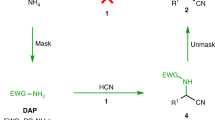Summary
Aqueous solutions of 0.1 M amino acid and 0.1 M trimetaphosphate maintained at chosen pH values between 8.0 and 10.5 and at room temperature in the presence of imidazole or 1,2,4-triazole give rise after a few days to the corresponding peptides. Yields are highest when the pH is adjusted with concentrated NaOH or KOH instead of ammonia; in some cases glycine is quantitatively transformed within 10–15 days into peptides, mainly diand tripeptides.
Similar content being viewed by others
References
Abelson PH (1966) Chemical events on the primitive Earth. Proc Natl Acad Sci USA 55:1365–1372
Ehler KW, Orgel LE (1976) N′,N′-Carbonyldiidazole-induced peptide formation in aqueous solution. Biochim Biophys Acta 434:233–243
Ferris JP, Sanchez RA, Orgel LE (1968) Studies in prebiotic synthesis. J Mol Biol 33:693–704
Hawker JR Jr, Oro J (1981a) Cyanamide mediated synthesis of Leu, Ala and Phe peptides under plausible primitive Earth conditions. In: Yolman Y (ed) Origin of life. D Reidel, Dordrecht, Holland, pp 225–232
Hawker JR Jr, Oro J (1981b) Cyanamide mediated synthesis of peptides containing histidine and hydrophobic amino acids. J Mol Evol 17:285–294
Holland HD (1984) The chemical evolution of the atmosphere and oceans. Princeton University Press, Princeton, New Jersey
Hulshof J, Ponnamperuma C (1976) Prebiotic condensation reactions in aqueous medium: a review of condensing agents. Orig Life 7:197–224
Ibanez JD, Kimball AP, Oro J (1971) Condensation of mononucleotides by imidazole J Mol Evol 1:112–114
Kerr RA (1980) Origin of life; new ingredients suggested. Science 210:42–43
Lahav N, White D, Chang S (1978) Peptide formation in the prebiotic era: thermal condensation of glycine in fluctuating clay environments. Science 201:67–69
Martin DW Jr, Mayes PA, Rodwell VW (1981) Harper's review of biochemistry, 18th ed. Lange Medical Publications, Los Altos, California
Miller SL (1957) The mechanism of synthesis of amino acids by electric discharges. Biochim Biophys Acta 23:480–489
Rabinowitz J, Hampaï A (1980) Influence of nitrogen heterocyclic compounds and of non condensed azoles in particular on “prebiotic” condensation reactions of α-amino acids induced by polyphosphates in aqueous solution. Helv Chim Acta 63:962–966
Rabinowitz J, Flores J, Krebsbach R, Rogers C (1969) Peptide formation in the presence of linear or cyclic polyphosphates. Nature 224:795–796
Weber AL Caroon JM, Warden JT, Lemmon RM, Calvin M (1977) Simultaneous peptide and oligonucleotide formation in mixtures of amino acid, nucleoside triphosphate, imidazole and magnesium ion. Biosystems 8:277–286
Yuasa S, Flory D, Basile B, Oro J (1984) On the abiotic formation of amino acids. I. HCN as a precursor of amino acids detected in extract of lunar samples. II. Formation of HCN and amino acids from simulated mixtures of gases released from lunar samples. J Mol Evol 20:52–58
Author information
Authors and Affiliations
Rights and permissions
About this article
Cite this article
Rabinowitz, J., Hampaï, A. Quantitative polyphosphate-induced “prebiotic” peptide formation in H2O by addition of certain azoles and ions. J Mol Evol 21, 199–201 (1985). https://doi.org/10.1007/BF02100094
Received:
Revised:
Issue Date:
DOI: https://doi.org/10.1007/BF02100094




